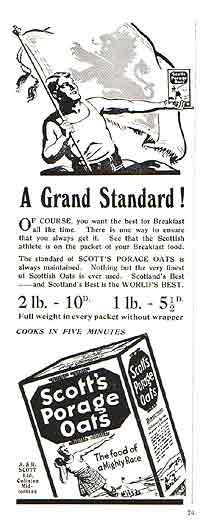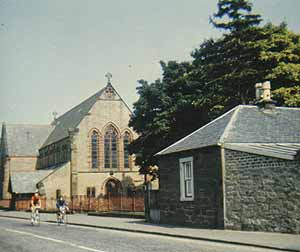Memories of Juniper Green
Growing up in Juniper Green ...
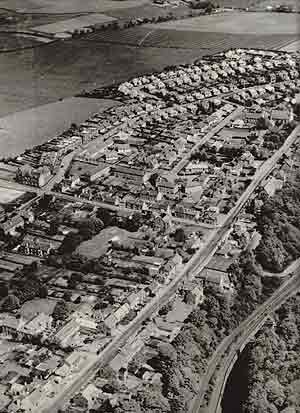
An aerial view of Juniper Green in the 1950s with Belmont Avenue in the picture but notice how little traffic there is on the Lanark Road
I was born and raised in Juniper Green during the 1940's and 1950's. I lived at 23 Belmont Avenue in a block of houses that no longer exist. The apartment that I grew up in could easily represent the village itself because, in almost every important sense, that village no longer exists.
The house was one of eight in a single block that was along the lane off the Avenue, the lane was known as Ivy Terrace. The other people who lived in the block were the Kerrs, the Tanseys, the Blacks, the Duncans, the Stenhouses, the Morams, and the Garwoods.
These houses consisted of a single room and a kitchen/living room. They were lit by gas using the extremely fragile gas mantles which tended to crumble at a glance. There was no hot water and we only had a cold water tap. Any hot water had to be boiled on the gas stove. I still get a thrill today in our condominium in Sechelt when I turn the tap and get hot water. Even now I tend to wash my hands in cold water. I guess that early habits are very hard to break. My acceptance of showers rather than baths was also an early habit. When I was 14 I joined Baberton Golf Course as a junior member. As we lived in Belmont Avenue and I had a locker at the club I used to take advantage of the shower in the golf club as often as I could.
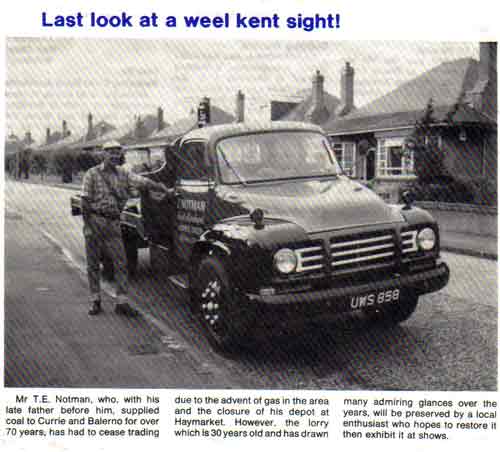
Mr Tommy Notman delivered coal around Juniper Green from his lorry for many years
Early in my childhood electricity came to the lane. I remember the workmen digging a trench in from Belmont Avenue along the lane to bring electricity in from the street. It was a wonder as the electricity was switched on. Each of the houses was heated by coal fires and we all had coal cellars which ranged along the back of the building next to the drying green. Coal was delivered in 112 pound sacks [1 hundred weight].
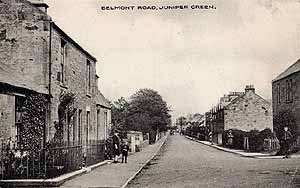
The city buses would use Belmont Road to turn around before returning to Edinburgh, a practice that continued into the 1980s
One of the by products of these coal fires was ashes which were useful when the roads were iced up in winter. The busses [numbers 8, 14 and 15] ran round the village in these days with the terminus being down at the north end of the Avenue right opposite my grandparents house and just around the corner from Belmont Road. These busses were all single deckers.
One of the curious features of returning to the village in the modern period is that the experience is surreal. In some respects the village appears similar but in other more important aspects it has changed beyond recognition. It is sometimes possible to catch glimpses of the old reality behind the modern fašade. To see buses bearing legends like SETON SANDS and PENCAITLAND passing through the village is disorienting. In my day these were strange and distant places of mystery beyond my ken. Indeed, in my childhood, I would say that the city of Edinburgh was a place of mystery where I seldom ventured. Until I went to secondary school in the town I was almost never in the city. However, my memories include trips to the exotically named Joppa on the old number 15 bus and visits to the foreshore at Cramond. These would be for walks with my Mum and Dad. I remember a nursery at Cramond where tomatoes that tasted like tomatoes could be bought. Unfortunately, I was mostly in a phase of disliking tomatoes as a youth and seldom enjoyed them. We also spent a lot of time walking over the hills which were a ready source of exercise and pleasure. One of the most pleasant features of Juniper Green was that it was possible to walk around Clubbiedean and Torduff and never have to retrace your footsteps. You set off towards Colinton and returned to the village via Currie. Juniper Green seemed to be a self contained village in these days although the fragmentary memory of a boy who grew up between 1942 and 1965 when I left the village for London never to return can hardly be considered a reliable source.
I went to Juniper Green primary school from August 1947 to June 1954 and then went into town for 6 years of high school. My memories of Juniper school are far from coherent and they form a kaleidoscope from which I can sometimes extract images and remembrances. The image below is of a Juniper Green Primary School class. I do not know either the teacher or the year although I think that it is probably from 1948 or 1949. It is taken from a photograph that appears to include at least two classes because of the age differences. If anyone can shed light on missing names then please contact the email address on this website.
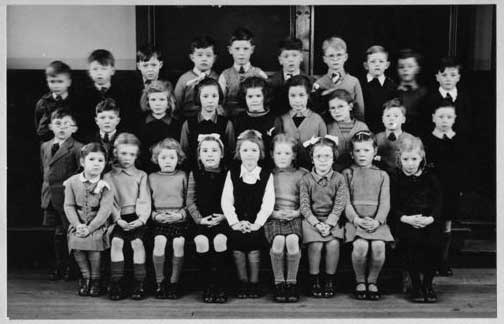
Back Row: Standing [from left to right] Billy More, Andrew Wilson, Ian Dea, Michael Kerr, Jack Corse, Ronnie Newman, ?, George Crabbe, James Cunningham, Gordon Young;
Middle Row: Standing [from left to right] Richard Allison [his father ran the local bakery which is now a funeral directors on Lanark Road], Eric Kermack, Kathleen Tait, Thelma Russell, Helen Pearson, ?, Anne Forrest, Walter Halkerston, Jim Todd;
Front Row: Sitting [from left to right] Maureen Barr, Irene Crabbe, Sheena Kerr, Helen Cochrane, Lesley Swanson, ?, Helen Inglis (family owned Inglis Grain Mill at Curriemuirend), ?, Anne ?.
The teachers I remember at the school include the following: Miss Spalding was the headmistress when I started but she retired and was replaced by Miss Fraser whose sister also taught at the school. Other teachers that I can remember were Miss McKenzie who was one of my first teachers, Miss Sloggie and Mrs. Simpson whose son went to the same high school as me. The Simpson's moved to the village around 1952 or so. I can remember her teaching us a lesson involving the Egyptian Pharaoh Tutankhamen. I think that Mrs. Simpson did this lesson as a student teacher but she shortly thereafter became a member of staff at the school. However, the finest teacher that I had at Juniper Green school was Miss Steele who was the aunt of Sir David Steele the well known Scottish politician. She was one of the old school who inspired or terrified her pupils [take your choice] towards excellence. My memory Inclines me to think that I had Miss Steele as a teacher both for primary 6 and 7. I feel that She had a powerful classroom presence and I benefited from this double dose of her teaching. this image below shows a section of the Primary 7 class taught by Miss Steele in 1953/4. Miss Steele took her graduating class on a trip to Dunfermline in 1954 and this group MAY have been taken at that time.
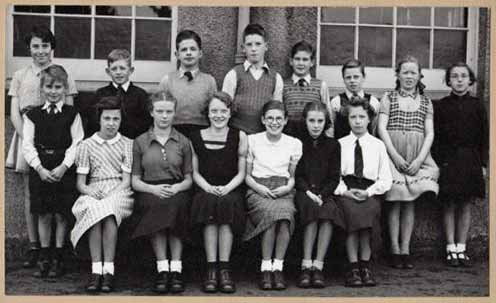
Back Row: Standing [from left to right] Linda Dorward, Billy More, George Crabbe, Michael Kerr, Jack Corse, Kendal Robinson, Jim Todd, ?, Helene Cochrane;
Front Row: Sitting [from left to right) Cynthia Russell, Kathleen Tait, Ann Gillies, Anne Forrest, Brenda Blackwood, Moira Whittles [she lived in the house at the top of the station brae which has now been demolished].
One of my most enduring memories of the school stems from my early years there. This was the appearance of a box of books which I think was a once a week occurrence. We could select a book from the box and spend the afternoon reading it. My response to this was total acceptance with joy and wonder.
Apart from the books at home my exposure to books was limited to Colinton Library which, in these days, was on the main street of the village and occupied a single floor of an old house. This was the gateway to the world and, for me, filled the role that the magic wardrobe did for the children in The Chronicles of Narnia. Now Colinton Library was served by the number 15 bus from Juniper Green. This bus did not run very often. I think that it was once an hour but even worse from my point of view was that it cost 3 old pence to get there and back on the bus - one and a half pence each way. This was quite a barrier in these days. Fortunately, the library lay within walking distance and many paths led to Colinton. The railway line featured goods trains in these days and wasn't available as a walkway but you could walk to Colinton on the highway or through Pass's farm and along past Campbell Park or down past Mossy Mill and along past Scott's Porage Oat mill to Colinton. It was a 3 mile round trip which if it wasn't raining was easily managed. Accessing the world of books was well worth the trip and I walked to the library many more times than I took the bus.
As I turn the kaleidoscope of childhood memories one of the most vivid images is of a variety of rope swings on the back braes. I have no recollection of ever seeing these swings being put up but I certainly recall swinging on them. A stout rope acquired from who knows where was slung up over a sturdy branch and secured in some unknown manner. A large knot was tied at the bottom of the rope and you simply grasped the rope firmly with two hands and then jumped up to sit on the knot. The natural declivity of the back braes facilitated the action of the rope swing. One specific swing I remember was just behind the station house off to the left of the station brae where the Christmas Tree lot is to be found these days.
I also recall another rope swing up behind Stewart's [Gilchrist's] at the top of the Avenue. This could be accessed from the regular path beside Miss Martin's shop or you could walk through the back yards behind the shop and climb over the wall.
Football in the park - the days of cock or hen for selection probably because none of us had any coins in our pockets. Football ranged from a general kick about featuring one or two people with jackets or jerseys for goalposts to more full fledged games depending on the numbers of people available. I do recall that once the game began with even distribution of participants newcomers had to wait until there was an even number when they would be allocated to the sides using some variant of the cock or hen selection process. I also remember that we did play cricket in the village park during the summer although football had the number one position in the hearts of the village youth. Almost all the youths were Hearts supporters although there was a Rangers supporter whose name was Fordyce [related to the great bowler from the Juniper Green bowling club]. I was a Hibs supporter in these days because all my relatives were Hearts supporters and also Hibs had one of the most exciting teams in Scotland in the late 1940's and early 1950's when my allegiances were formed. After I went into town to school I turned to rugby which I played for three years and continue to watch today whenever I can although Canada is not really a rugby friendly place. Another memory from this time is that Paddy Doyle, who was the school janitor and who lived in the school house on Baberton Avenue, tried to get a Juniper Green football team going. I don't remember much about this apart from the fact that he wanted me to be a goalkeeper because of my height. Paddy Doyle was from the north of England.
Endless and shapeless games in the streets of the village which in these days seldom saw any traffic apart from the odd bus. Number 8 from the village to the Waverly Bridge, and numbers 14 and 15. In these games which were essentially variations of Hide and Seek we ranged through the various pends and back yards of the houses on the Avenue in as much as this was possible. One of the games that I remember featured the use of metal bicycle wheels which we propelled around the houses in Ivy Terrace which served as a narrow track. I think that the wheels themselves were called girs. These "races" could be considered as a form of mini speedway which was a big sport in Edinburgh in the 1950's. The Edinburgh Monarchs raced at Meadowbank.

This is an image of the weir that stood between Woodhall Mill and Juniper Green Station in Jack's youth
Areas of uncleared ground on the Avenue provided fun, there was a yard at the end of Ivy Terrace just where Miss Bryce had a small sweet shop and there was a general yard at the top of the Avenue across from the Store. This had three large trees on the Avenue and a large Holly tree on Lanark Road. The Holly Tree was an easy tree to climb but the three on the Avenue did not seem to be climbable. Of course, the Muir Wood which lay up the road towards Currie provided access to all sorts of activities including tree climbing and looking for frogs and tadpoles at the appropriate times of the year. I remember plowtering around by the Water of Leith although I do not recall any fishing or swimming in the river.
The weir raised a head of water which ran under the station brae through a fairly large tunnel. The weir has since been demolished and the tunnel opening blocked.

